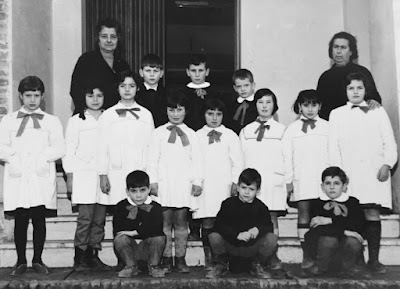Also for the school, Rivalto reserves an own story full of curiosities and anecdotes, partly evidenced by documents and pictures of the time, in part passed down by oral tradition from generation to generation.
 |
| Pupils of Rivalto in 1965 |
In particular, the college has been an experience that has "marked" for better or for worse, many children of those times. On the one hand, leaving an indelible sign of detachment from the relatives and impatience with the exasperated discipline imposed, on the other setting up, especially during the war and after the war, the only educational opportunity that working mothers, left alone for the call to arms of their husbands, could provide to their children. After the war, in particular, to reach the college in the neighboring countries, the children had to go through the campaigns for hours because the German retreat had blown up all the bridges and made impassable the roads. At the time, however, transport were quite limited, so when occasionally families went to visit their children in college, they did it on board of the barrocci (traditional carts driven by horses or donkeys. Donkey in italian is somaro but in Tuscany it is usually called ciuco).
Without going too far back in time, when teaching was exclusively run by the Church and its priests, since there were no secular schools, we can remember that, from the second half of 1800 to the first half of 1900 in Italy there have been a series of reforms in education aimed to regulate the compulsory attendance, to make education more democratic for low-income families and more comfortable for disadvantaged centers, to improve the status and the compensation of teachers.
Without going too far back in time, when teaching was exclusively run by the Church and its priests, since there were no secular schools, we can remember that, from the second half of 1800 to the first half of 1900 in Italy there have been a series of reforms in education aimed to regulate the compulsory attendance, to make education more democratic for low-income families and more comfortable for disadvantaged centers, to improve the status and the compensation of teachers.
According to these premises, one can easily imagine how, for a long time, elementary schools in Rivalto were organized in "multi-classes" to deal with the shortage of funds, teachers and school buildings.
Among the classrooms, hosted in various "provisional" local of private, taken from time to time for rent by the municipality, we remember those in:
- Piazza Beato Giordano, at the home of Cortesi's family, at least until 1925
- Piazza della Compagnia, at least until 1952, at Falugi's building -of properties Sor Ottorino Falugi- and Giovanelli's building -the Giovannelli's family was from Santa Luce and at that time had some lands in Rivalto-
- Via del Fondaccio, at Nildo Caminarecci's home, where they were housed two classes, one on the ground floor and the other on the first floor
- Piazza Beato Giordano, at the home of Rino Falugi
| Falugi's building |
| Giovannelli's building |
| The former home of Fascism |
Later, after the war, the school moved into the former home of Fascism (ex casa del Fascio), in Via Vespucci which, in previous years, had a plaque praising Mussolini with written on "During the five months of the economic siege, Rivalto built his house beam". Plaque which was subsequently removed.
| The Schools of Rivalto |
 |
| Inauguration of the Rivalto's school - school year 1959-1960 |
 |
| Don Capitini with his pupils in 30's |
Among the teachers originating in Rivalto, we mention:
- Guglielmina Costagli Del Lucchese
- Alfreda Falugi, sister of General Falugi, also known as "The Miss” for her single status
- Carlina Falugi Cecconi
